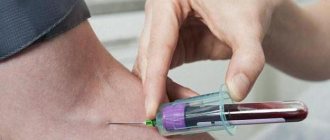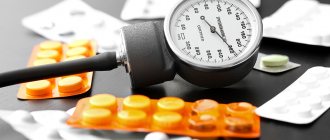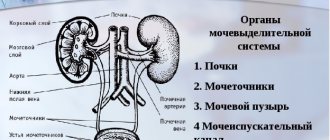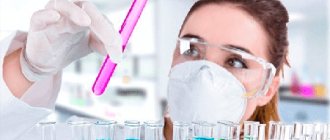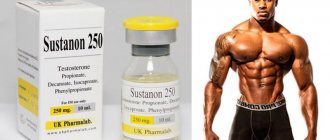Hypogonadism
Blackheads (acne)
Cervical cancer
15230 16 October
IMPORTANT!
The information in this section cannot be used for self-diagnosis and self-treatment.
In case of pain or other exacerbation of the disease, diagnostic tests should be prescribed only by the attending physician. To make a diagnosis and properly prescribe treatment, you should contact your doctor. We remind you that independent interpretation of the results is unacceptable; the information below is for reference only.
Testosterone: indications for use, rules for preparing for the test, interpretation of results and normal indicators.
Normal testosterone levels in men, women and children
The study of testosterone levels is not limited to men, because women and children also produce small amounts of this substance in their bodies. The only difference is the place of production of the hormone: in men it is synthesized in the testes, in women ¾ in the adrenal cortex and a small part ¾ in the ovaries. In the female body, the function of the hormone is aimed at the development of secondary sexual characteristics, stable and healthy functioning of the reproductive system, as well as the synthesis of some protein components.
Children and adolescents need sufficient amounts of the substance due to active growth and development. Without the hormone in adolescence, the development of the musculoskeletal system, the growth of the bone skeleton and the development of the muscular system are impossible.
Testosterone circulates in the bloodstream both in free form and in a protein-bound state. Only 2% of the substance is the free fraction of the substance; the remaining amount is associated with albumins, globulins and other proteins of the human body.
The doctor usually prescribes a testosterone test in men, women or children to assess its total, total fraction. If the study revealed low testosterone, a more specific diagnosis will be needed - a test for bound testosterone.
The testosterone level in men is within certain limits depending on the age of the person being studied:
- in boys under 18 years of age, the concentration of the hormone in the blood ranges from 0.2 nmol/l to 37.67 nmol/l;
- in men aged 18-50 years ¾ from 5.76 nmol/l to 30.43 nmol/l;
- in men over 50 years old, ¾ in the range of 5.41–19.54 nmol/l.
- Female testosterone levels are considered normal if they are within the following values:
- in girls under 18 years of age, the concentration of the hormone in the blood ranges from 0 to 4.73 nmol/l;
- in women over 18 years of age ¾ from 0.31 to 3.78 nmol/l;
- in pregnant women, the concentration of the hormone increases 3-4 times compared to the age norm;
- during the postmenopausal period ¾ 0.42–4.51 nmol/l.
however, normal values are sometimes subject to individual fluctuations. Therefore, the interpretation of the test should be handled solely by your doctor.
When do hormone levels increase?
In women, a slight increase in hormone levels can be observed when taking COCs (combined oral contraceptives), as well as during pregnancy. In both men and women, increased testosterone is a consequence of taking anticonvulsants (for example, therapy for epilepsy), as well as during treatment for hyperthyroidism.
An increase in testosterone is a clear signal that allows one to suspect the development of the following conditions in a patient:
- development of adrenogenital syndrome in women;
- the risk of tumor formation in the ovaries in women and testicles in men;
- Itsenko-Cushing's disease ¾ endocrine pathology, in which there is excessive synthesis of ACTH (adrenocorticotropic hormone) at the level of the brain, which leads to increased activity of the adrenal cortex, where, in particular, testosterone is produced;
- Reifenstein syndrome (male pseudohermaphroditism);
- tumor process in the pituitary gland;
- excessive physical activity of patients;
- in some professional athletes taking steroid drugs.
Increased testosterone ¾ is an important symptom that cannot be ignored. When testosterone increases, the doctor, as a rule, conducts additional diagnostics to find out the reasons for the change in the level of the hormone in the patient’s body.
Ban on free sale in pharmacies[edit | edit code]
Since August 16, 2014, a new list of drugs for subject-quantitative recording has been in effect in Russia.[5] Almost all injectable testosterone preparations are banned:
- "Testosterone propionate" (solution for intramuscular administration)
- "Andriol TK" (capsules)
- "Nebido" (testosterone undecanoate solution for intramuscular administration)
- "Sustanon-250" (solution for intramuscular administration)
- "Omnadren-250" (solution for intramuscular administration).
When does a decrease in hormone levels occur?
In men over 50 years of age, reproductive function begins to decline physiologically, which is accompanied by a decrease in testosterone levels. However, doctors often talk a lot about how to increase testosterone in men in natural ways, so you should not worry about a decrease in the level of the hormone if this is the age norm.
Cause for concern arises when low testosterone appears in a man aged 18-50 years, and the patient's hormone level differs significantly from the testosterone norm for men in this age group.
A decrease in the level of the substance often indicates the development of the following pathological conditions:
- diseases of the pituitary gland ¾ functional or organic lesions of the pituitary gland, which lead to disruption of the synthesis of gonadotropic hormones, which affects the production of testosterone in the gonads;
- pathology of the hypothalamus, which controls the function of the pituitary gland;
- pathology of the adrenal glands: insufficiency of adrenal cortex function, other diseases;
- active use of certain medications, glucocorticosteroid substances;
- hypogonadism (insufficient function of the gonads);
- chronic prostatitis ¾ inflammation of the prostate gland;
- male obesity, female alcoholism;
- malnutrition ¾ insufficient amount of protein in the diet, increased level of “fast” carbohydrates that are easily digested;
- certain dietary rules ¾ vegetarianism, long-term fasting;
- liver cirrhosis, renal failure;
- endocrine disorders that cause an imbalance in the ratio of male and female sex hormones in the human body.
A decrease in hormones in a woman by ¾ is not a very dangerous and formidable sign. As a rule, hormone levels naturally decrease during menopause. However, in this case, it may be necessary to increase testosterone in a natural way, because a lack of the hormone in the body often leads to osteoporosis, increased bone fragility, and affects the psycho-emotional sphere. For example, a woman may experience long periods of depression, insomnia, and even suicidal thoughts.
The level of the hormone in the body is determined using a special blood test. A diagnostic study allows you to detect the problem and begin drug treatment of the patient’s pathology.
Causes of decreased testosterone
- congenital pathology (Klinefelter syndrome, cryptorchidism)
- diseases of the pituitary gland, hypothalamus
- viral parotitis suffered after 12 years of age
- scrotal injuries
- increased levels of prolactin in the blood (hyperprolactinemia)
- aging
- obesity, diabetes mellitus, metabolic syndrome
- lack of physical activity
- vegetarianism, limiting animal fats in the diet (testosterone is formed from cholesterol)
- taking medications (anabolic steroids, corticosteroids)
- stress
- smoking, drinking alcohol, drugs
What to do with high and low testosterone levels?
High testosterone or low testosterone ¾ are manifestations of some physiological and pathological processes occurring in the human body. Often, a doctor prescribes a blood test for testosterone if he already suspects the formation of any pathology.
For example, the following conditions are considered indications for research:
- doctor's suspicion of female or male infertility;
- tumor process in the adrenal glands or gonads;
- the patient has a certain degree of obesity;
- formation of osteoporosis;
- skin manifestations ¾ acne, which may indicate a significant increase in testosterone levels, oily seborrhea;
- baldness.
In addition, a doctor prescribes a testosterone test in men if he suspects erectile dysfunction or decreased function of the gonads (hypogonadism). Low testosterone is often found in men who experience decreased libido. It is also necessary to check testosterone levels if you suspect the development of chronic prostatitis or osteoporosis. An enlarged mammary gland, as well as insufficient hair on the face and chest, also become a suspicious symptom. Disruption of the process of puberty in boys during adolescence, excessive sweating are also indications for checking testosterone levels.
Women are recommended to undergo diagnostics if they have the following manifestations or suspect the formation of such diseases:
- unstable menstrual cycle, cycle disorders;
- the appearance of uterine bleeding;
- disturbances in the course of pregnancy ¾ miscarriage;
- the formation of multiple cysts in the ovaries (polycystic ovary syndrome);
- endometriosis.
Thanks to the testosterone test, the doctor will be able to detect the pathology that has arisen in the patient’s body. Diagnosis of testosterone levels is one of the most effective methods for assessing the risk of formation of a tumor process and disorders in the reproductive system of men and women. So, after receiving the results of the study, the doctor selects the treatment tactics necessary for the patient with individual dosages of drugs, and after some time, using repeated analysis, monitors the dynamics of treatment.
Sometimes the doctor recommends changing your diet and adding testosterone-boosting foods to your daily meals. At the appointment, the doctor will talk about how to increase testosterone in men in natural ways if the analysis revealed a decrease in the concentration of the hormone. Therefore, the question of how to do this is not too pressing in modern medicine: effective and affordable treatment methods ensure rapid restoration of the patient’s body functions. Naturally, during therapy and after treatment it is necessary to follow all the recommendations of the attending physician.
Testosterone norm
Men have different levels of total testosterone at the start. For some, it is initially high at a young age (10 or more ng/ml), for others it is medium (7 ng/ml), and for others it is low (4 or below ng/ml). A decrease in the initial level by 2-3 ng/ml causes certain symptoms in everyone, but the testosterone level is different.
Therefore, competent doctors, to decide on the advisability of using hormone replacement therapy, first of all pay attention to the patient’s complaints, and not to the level of total blood testosterone.
Preparing for diagnosis. How is the analysis carried out?
At the first stage, the patient receives a referral for research. The document is issued to the person by a gynecologist, endocrinologist, andrologist, reproductologist ¾ doctor to whom the patient turned for advice. However, diagnosis requires careful preparation. This is necessary to increase the accuracy of the study.
For example, it is prohibited to donate blood for testosterone if during the day before the test you performed ultrasound diagnostics, fluorographic examination, or underwent physiotherapeutic procedures. Rectal examination during the day can also distort the results of a blood test.
The patient is obliged to warn the doctor about taking hormonal drugs (for example, if a woman takes combined oral contraceptives as a method of contraception), as well as gel-based substances and ointments. The doctor will decide on the need to temporarily stop taking medications if this does not threaten the patient’s condition. It is allowed to donate blood for testosterone 2 weeks after stopping taking hormonal medications.
24 hours before diagnosis, any physical activity or drinking alcohol is prohibited. In addition, you need to stop smoking and change your diet slightly: do not eat fatty or fried foods the day before the diagnosis. Blood sampling for testosterone levels is carried out in the morning (before 11 am) on an empty stomach. During this period, the amount of the hormone in the blood reaches its maximum value.
In addition, to avoid distortion of the results during the diagnosis (for example, increased testosterone or low testosterone when receiving diagnostic results), it is necessary to stop drinking coffee, stimulating drinks, and also avoid stress and nervous tension 1 hour before the procedure.
Attention! The patient should warn the doctor if his diet differs from the normal diet. For example, followers of vegetarianism or people who exclude certain foods from their diet need to tell their doctor about this in order to correctly interpret the diagnostic result.
Preparing for a blood test for testosterone in women has its own characteristics and depends on the menstrual cycle. It is believed that the collection of biological material should be carried out on days 6-7 of the menstrual cycle. The patient's blood serum is used as diagnostic material. The research method is called enzyme-linked immunosorbent assay (ELISA).
Sources[edit | edit code]
- Breiner M, Romalo G, Schweikert HU (Aug 1986). "Inhibition of androgen receptor binding by natural and synthetic steroids in cultured human genital skin fibroblasts." Klinische Wochenschrift. 64 (16): 732–37.
- Kelly MJ, Qiu J, Rønnekleiv OK (2005-01-01). "Estrogen signaling in the hypothalamus". Vitamins and Hormones. 71: 123–45. doi:10.1016/S0083-6729(05)71005-0. PMID 16112267.
- https://jem.rupress.org/content/early/2017/05/05/jem.20161807
- https://www.ncbi.nlm.nih.gov/pubmed/11701431
- Letter of the Ministry of Health of Russia dated 09/03/2014 N 25-4/10/2-6691 “On the implementation of substantive and quantitative accounting of medicines”
- https://time.com/3633813/spicy-food-testosterone/
- https://www.ncbi.nlm.nih.gov/pubmed/28376340
Progress of the study
The patient is recommended to come to the laboratory 30 minutes before blood sampling in order to adapt to external conditions and normalize breathing. In a laboratory setting, blood is taken from a patient’s vein.
A standard set of materials is used: a disposable syringe or a special system. As a rule, the patient does not experience discomfort because a small amount of blood is needed for diagnosis. After 1-2 days, the laboratory provides diagnostic results on a special form. The interpretation of the results of the analysis is carried out exclusively by a doctor who knows the characteristics of the patient’s body.
The level of the hormone can be influenced by many different factors, ranging from stressful situations and nervous tension, to a specific diet and the presence of bad habits. Chronic diseases, episodes of decreased immune defense, use of steroid substances - these conditions can cause changes in the amount of testosterone in the human body.
In addition, testosterone levels often depend on the time of year.
For example, in the fall there is an increase in the hormone in the human body. Therefore, independent interpretation of research results in most cases turns out to be incorrect. So, the analysis should only be deciphered by your attending physician.
How to maintain hormone levels?
An increase in hormone levels, depending on the reasons, is often corrected with medication. The doctor prescribes a specific treatment regimen and then monitors the effectiveness of the treatment. However, there are situations when testosterone levels are low, and a man thinks about how to increase it in natural ways. This is a simple process if it does not concern organic pathology, and the decrease is explained only by functional reasons. Many doctors talk about how to increase testosterone, highlighting several main ways to solve the problem:
- Proper and rational nutrition. Doctors insist on eating foods rich in zinc, vitamins, microelements and other beneficial substances.
- Rational physical activity. During active sports, testosterone is actively released, which allows you to increase the level of the hormone in a natural way.
- Getting rid of excess weight, eliminating factors that contribute to excess weight gain (decreased physical activity, consumption of fatty, fried, overly processed foods).
- Competently designing a working day that corresponds to your biological clock. Rational distribution of work and rest time will help the body clearly and correctly adjust the hormonal balance.
- Refusal of nutritional supplements and products that stimulate the production of estrogen - the female sex hormone, which is found in small quantities in the male body. With the active production of estrogen, the intensity of testosterone synthesis in a man decreases.
These five ingredients will help increase testosterone naturally. Special attention must be paid to proper diet, because nutrients, vitamins, and minerals supplied with food become the basis for metabolic processes in a man’s body. Therefore, it is very important for a man to follow the principles of a healthy diet.
Interesting facts[edit | edit code]
A study by French scientists showed that men who eat spicy foods have higher testosterone levels, and therefore increased sexual activity. The results of the work are presented in the journal Physiology & Behavior.[6]
A study[7] conducted on 1113 men showed that marital status plays an important role in a man’s hormonal background. Testosterone decreases significantly after marriage. This is associated with the evolutionary mechanism of limiting the search activity of a new partner and greater commitment to the family.

